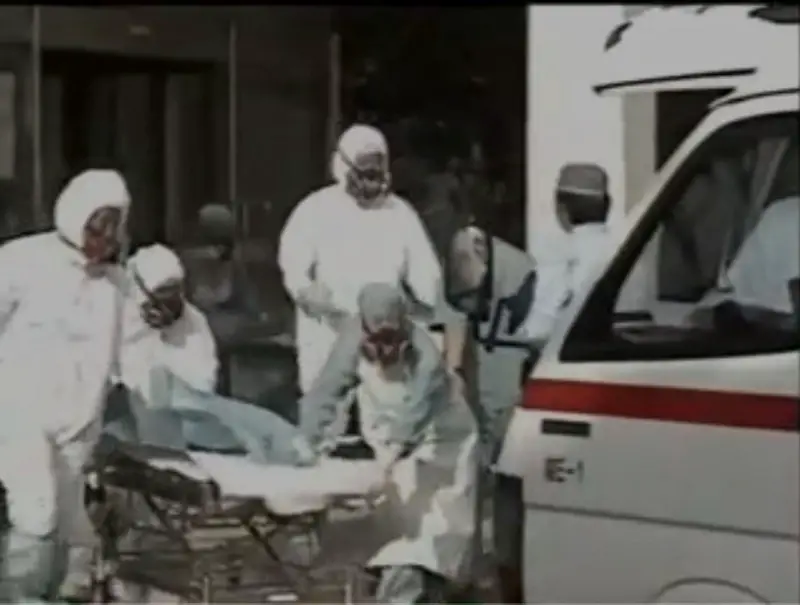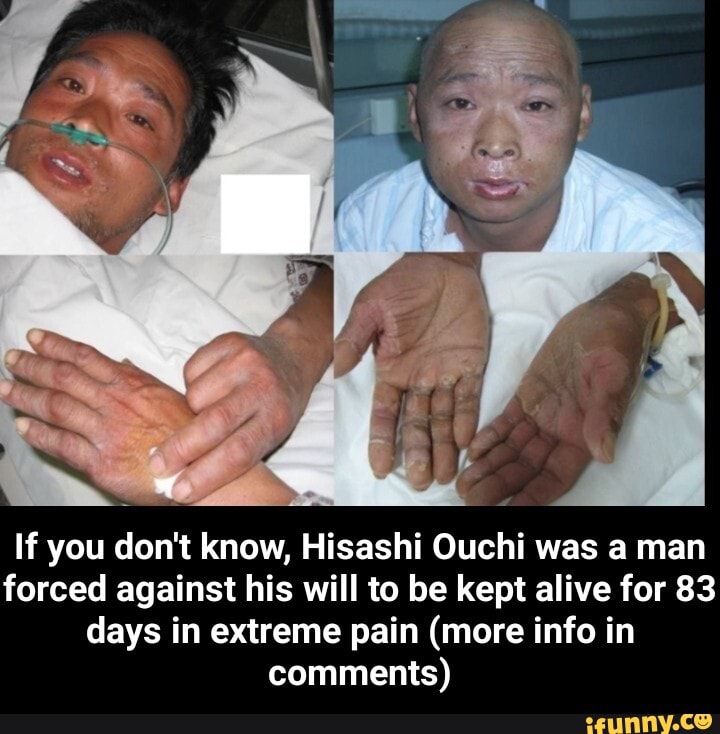Hisashi Ouchi's story remains one of the most haunting and significant cases in the history of radiation exposure. This article delves into Hisashi Ouchi's journey during his hospitalization, the medical challenges faced, and the profound impact of his case on radiation safety. If you're searching for Hisashi Ouchi pictures hospital, this article will provide detailed insights and reliable information.
Hisashi Ouchi's tragic incident at the Tokaimura nuclear accident in 1999 sent shockwaves across the globe. His experience highlighted the dangers of radiation exposure and the importance of safety protocols in nuclear facilities. This article aims to explore Hisashi Ouchi's hospitalization journey, the medical procedures he endured, and the lessons learned from this unfortunate event.
Through this article, we aim to provide a balanced and informative perspective on Hisashi Ouchi's case. By understanding the medical procedures, challenges, and outcomes, we can better appreciate the gravity of radiation exposure and the advancements in medical science. Let us now explore the key aspects of Hisashi Ouchi's hospitalization and its lasting impact.
Read also:Robin Weigert Young Rising Star In The Entertainment Industry
Table of Contents
- Biography of Hisashi Ouchi
- The Tokaimura Accident: What Happened?
- Hisashi Ouchi's Hospitalization
- Hisashi Ouchi Pictures Hospital: A Closer Look
- Medical Care and Treatment
- Impact on Radiation Safety
- Media Coverage and Public Reaction
- Challenges Faced by Medical Teams
- Lessons Learned from Hisashi Ouchi's Case
- Future Implications and Advancements
Biography of Hisashi Ouchi
Hisashi Ouchi was born on January 26, 1968, in Japan. He worked as a technician at the JCO nuclear fuel processing plant in Tokaimura. Below is a summary of Hisashi Ouchi's personal information:
Biodata
| Full Name | Hisashi Ouchi |
|---|---|
| Date of Birth | January 26, 1968 |
| Place of Birth | Japan |
| Occupation | Technician at JCO Nuclear Fuel Processing Plant |
| Notable Incident | Tokaimura Criticality Accident (1999) |
Hisashi Ouchi's life took a tragic turn on September 30, 1999, when he became one of the victims of the Tokaimura nuclear accident. His story has since become a pivotal case study in the field of radiation safety.
The Tokaimura Accident: What Happened?
The Tokaimura nuclear accident occurred on September 30, 1999, at the JCO nuclear fuel processing plant. It was caused by a criticality event, which happens when nuclear material reaches a state where nuclear chain reactions occur uncontrollably. Hisashi Ouchi and two of his colleagues were exposed to lethal doses of radiation during this incident.
Causes of the Accident
- Inadequate safety protocols
- Violation of standard operating procedures
- Human error in mixing nuclear material
Hisashi Ouchi received a radiation dose of approximately 17 sieverts, which is far beyond the lethal limit. This exposure led to severe health complications and ultimately his hospitalization.
Hisashi Ouchi's Hospitalization
Following the accident, Hisashi Ouchi was rushed to the University of Tokyo Hospital, a renowned medical facility equipped to handle radiation exposure cases. His hospitalization lasted for 83 days, during which he underwent extensive medical treatment.
Initial Assessment
Upon arrival at the hospital, Hisashi Ouchi's condition was critical. Medical professionals immediately assessed the extent of his radiation exposure and initiated life-saving measures. The initial assessment revealed severe damage to his internal organs and bone marrow.
Read also:Leonardo Maria Del Vecchio Exwife Unveiling The Untold Story
Hisashi Ouchi Pictures Hospital: A Closer Look
Hisashi Ouchi pictures hospital have been widely circulated in the media, capturing the harrowing reality of his condition. These images depict the medical equipment used during his treatment and the efforts made by the medical staff to stabilize his condition.
Significance of the Pictures
- Illustrate the severity of radiation exposure
- Highlight the challenges faced by medical teams
- Provide a visual record of Hisashi Ouchi's hospitalization
While these pictures are difficult to view, they serve as a powerful reminder of the dangers of nuclear accidents and the importance of safety measures.
Medical Care and Treatment
Hisashi Ouchi's medical care involved a multidisciplinary approach, combining expertise from various fields to address the complex health issues caused by radiation exposure.
Key Treatments
- Bone marrow transplantation
- Administration of antibiotics to prevent infections
- Supportive care for organ dysfunction
Despite the best efforts of the medical team, Hisashi Ouchi's condition continued to deteriorate due to the extensive damage caused by radiation exposure.
Impact on Radiation Safety
Hisashi Ouchi's case had a profound impact on radiation safety regulations and protocols worldwide. It underscored the need for stricter adherence to safety guidelines in nuclear facilities.
Key Changes Implemented
- Enhanced safety training for employees
- Improved monitoring systems for nuclear materials
- Increased emphasis on regulatory compliance
These changes aim to prevent similar incidents in the future and ensure the safety of workers and the public.
Media Coverage and Public Reaction
The Tokaimura accident and Hisashi Ouchi's hospitalization garnered extensive media coverage, sparking public concern about nuclear safety. The media played a crucial role in disseminating information and raising awareness about the dangers of radiation exposure.
Public Reaction
Public reaction to the incident varied, with many calling for stricter regulations and accountability in the nuclear industry. The case also highlighted the need for transparency and communication between nuclear facilities and the communities they serve.
Challenges Faced by Medical Teams
The medical teams treating Hisashi Ouchi faced numerous challenges due to the unprecedented nature of his case. The high levels of radiation exposure made it difficult to provide effective treatment.
Key Challenges
- Limited understanding of extreme radiation exposure
- Difficulty in managing organ failure and infections
- Emotional toll on medical staff
Despite these challenges, the medical teams demonstrated remarkable dedication and resilience in their efforts to save Hisashi Ouchi's life.
Lessons Learned from Hisashi Ouchi's Case
Hisashi Ouchi's case provides valuable lessons for the nuclear industry and society as a whole. It emphasizes the importance of safety, preparedness, and continuous improvement in nuclear operations.
Key Lessons
- Importance of rigorous safety protocols
- Necessity of emergency preparedness and response plans
- Value of international cooperation in addressing nuclear safety
By learning from Hisashi Ouchi's case, we can work towards a safer and more secure nuclear future.
Future Implications and Advancements
The lessons learned from Hisashi Ouchi's case have driven advancements in radiation safety and medical treatment. Ongoing research and development aim to improve our understanding of radiation exposure and its effects on the human body.
Future Developments
- Innovations in radiation detection and monitoring
- Advancements in medical treatments for radiation exposure
- Enhanced global cooperation on nuclear safety
These developments hold promise for a safer and more secure nuclear future, ensuring that tragedies like Hisashi Ouchi's case become a thing of the past.
Kesimpulan
Hisashi Ouchi's hospitalization following the Tokaimura nuclear accident remains a pivotal case in the history of radiation exposure. Through this article, we have explored Hisashi Ouchi's journey, the medical challenges faced, and the profound impact of his case on radiation safety.
We invite you to share your thoughts and insights in the comments section below. Additionally, feel free to explore other articles on our site for more information on related topics. Together, we can continue to learn and grow from the lessons of the past.


